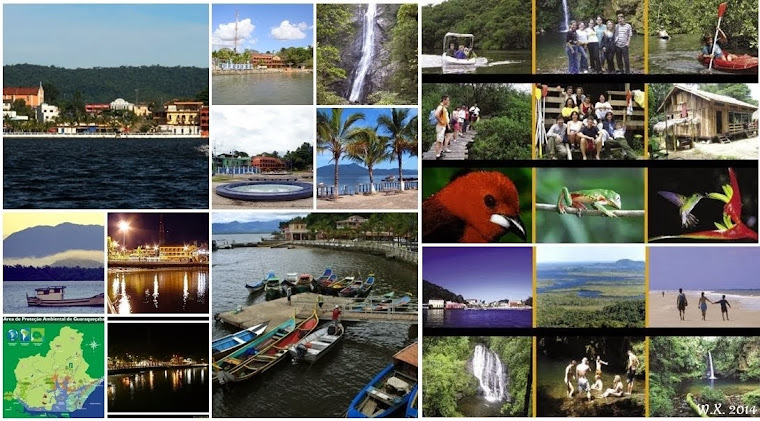Guaraqueçaba:
como chegar e o que fazer entre a serra e o mar
Motivos
pra conhecer Guaraqueçaba, no litoral do Paraná, existem de sobra. A cidade
fica dentro da maior reserva de mata atlântica do país, cercada por ilhas,
praias desertas, animais em extinção, cachoeiras e história. De Curitiba até lá
são apenas 160 quilômetros e dá pra descer a Serra do Mar pela deliciosa
Estrada da Graciosa.
Como ir a Guaraqueçaba por
estrada
Se você faz parte do time dos corajosos ou gosta de
off road, vai aproveitar o percurso que corta a mata atlântica da serra ao mar.
Dê uma olhada no mapa:
VIA ESTRADA DA GRACIOSA
Saindo de Curitiba pela BR 116, sentido São Paulo,
você encontra o portal de acesso para a Estrada da Graciosa ( PR 410) a cerca
de 40 km da cidade. Depois de descer a serra, um pouco antes de Antonina, entre
na PR 340, sentido Cacatu, e siga até o trevo com a PR 405, a estrada de terra
que leva a Guaraqueçaba.
VIA BR 277
A partir de Curitiba, siga pela estrada duplicada
que leva ao litoral do Paraná até o km 30 e vire no trevo que indica Morretes e
Antonina. Antes de chegar a Antonina, entre na PR 340 e depois, seguindo a
sinalização, pegue a PR 405.
Barcos
comerciais partem de Paranaguá às 09h00 (todos os dias) e às 13h30 (exceto
domingos e feriados). O cais fica na Rua da Praia ( o nome oficial é R. General
Carneiro) em frente ao restaurante Danúbio. A passagem custa R$30,00. Retorno
às 07h e 14h.
Pra
quem está turistando, funciona como um passeio. O barco passa próximo ao porto
de Paranaguá mas segue um caminho diferente dos grandes navios. Em meia hora,
você está no meio da baía com as montanhas de um lado e as ilhas do outro,
incluindo a mais famosinha Ilha do Mel.
O que ver e fazer em Guaraqueçaba
Guaraqueçaba
é de uma tranquilidade só. O movimento só aumenta um pouco nos fins de semana
de temporada. A praça e as construções históricos formam uma espécie de
semicírculo de frente para a baía.
Da
época de ouro da cidade, na virada do século 19 para o 20, restam poucos
prédios. O antigo mercado municipal, diante do trapiche, abriga um posto de
atendimento ao turista. A boa conservação contrasta com o edifício vizinho, um
belo casarão que ameaça desabar.
Subindo a rua ao lado,
chega-se à Igreja de Bom
Jesus dos Perdões, a construção mais antiga da cidade, erguida
em 1838 aos pés do Morro
Quitumbê. Uma trilha de 600 metros parte dos fundos da igreja e
leva ao alto do morro, um belo mirante natural pra quem tem força nas pernas.
Passeios em Guaraqueçaba
Além de apreciar a vista bucólica do centrinho, há
também As atrações fora da cidade, nas matas e nas ilhas da grande área de
proteção ambiental de Guaraqueçaba.
Os passeios que levam ou pela floresta ou pelo mar
não são complicados, mas é melhor reservar um dia para cada um e aproveitar o
resto do tempo pra relaxar na pousada. Outra opção é conhecer a linda Ilha de
Superagüi.
Reserva Particular
Salto Morato
O acesso para a reserva particular fica a 23
quilômetros da cidade.
Vale a pena o passeio. O lugar é bem
organizado, com centro de visitantes, material educativo, banheiros decentes e
bebedouros. A entrada custa 10 reais (crianças não pagam). A lanchonete e o
trabalho de orientação funcionam de terça a domingo.
Há duas trilhas demarcadas e bem fáceis de
percorrer. A Trilha da
Figueira leva a uma arvore centenária que projeta as raízes
sobre o rio. A trilha principal, com 1500 metros no meio da mata, chega até os
pés do Salto Morato,
uma cachoeira linda de 100 metros de altura.
Onde ficar

























.jpg)
































